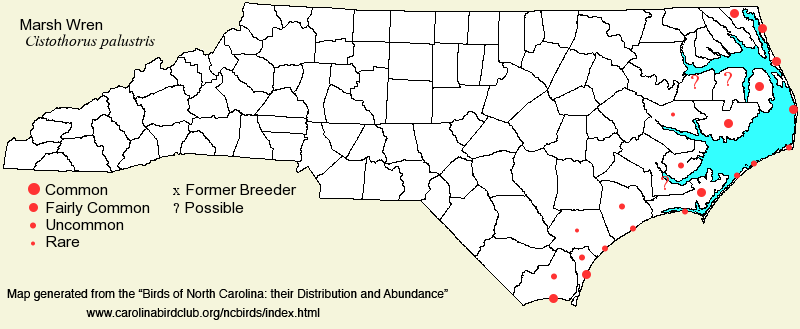 |  |
|
Marsh Wren - Cistothorus palustris TROGLODYTIDAE Members: | Search Common: Search Scientific: |
|
|
|||||||
| General Comments | The Marsh Wren was formerly named the Long-billed Marsh Wren, thus causing some confusion with the Short-billed Marsh Wren, which was changed to Sedge Wren at the same time that the former species had its common name shortened. The Marsh Wren breeds from coast to coast, but because it nests in naturally localized and uncommon habitats, it has evolved a number of subspecies; some scientists want to see some of the Western subspecies split off as a new species. In the East, it nests both in freshwater marshes to the north of North Carolina, but also in brackish marshes south to central Florida. Despite it nesting in freshwater marshes over much of its range, it has never done so in inland marshes in our state, staying close to tidal water in summer. In the breeding season in the state, Marsh Wrens favor extensive brackish marshes, though they occur in fresh (actually very slightly brackish) marshes in the Currituck Sound area. In migration, it occurs statewide, and in winter it occurs over much of the Coastal Plain, and sparingly into the eastern and southern Piedmont (though actual overwintering there is uncertain). | ||||||
| Breeding Status | Breeder | ||||||
| NC BRC List | Definitive | ||||||
| State Status | |||||||
| U.S. Status | |||||||
| State Rank | S3B,S4N | ||||||
| Global Rank | G5 | ||||||
| Coastal Plain | Permanent resident in coastal areas, with migratory movements; transient and scarce winter resident farther inland. In summer, fairly common to locally common along the coast and margins of Pamlico Sound; scarce in some areas, such as much of the Outer Banks. In Tidewater, a very local breeder, mainly along Pamlico Sound. Farther inland, uncommon and easily overlooked transient in both spring and fall, and rare in winter. Boundaries of the winter range are poorly known, as few birders spend time around freshwater marshes in the region. Inland, mainly mid-Sep to early May; scarce in late winter. Peak counts (at least in the breeding season): 75, heard along NC 12 through Cedar Island NWR, 20 Jul 2017. | ||||||
| Piedmont | Transient, and straggler into winter (few overwinter). Rare to locally uncommon in spring and fall across most of the region (though actually not really rare, but just secretive and overlooked). Very rare to rare in early winter in the eastern and southern portions, but few overwinter. A bird at Lake Brandt (Guilford) from 3-5 Jul 1987 built a dummy nest, but no female was ever observed. Mainly late Mar to early May, and early Sep to early Nov. Peak counts: 100 (after Hurricane Flossy), Greensboro, 29 Sep 1956 was a remarkable count. | ||||||
| Mountains | Transient. Rare (but easily overlooked) in low elevation valleys; casual to very rare at higher elevations. Mainly mid-Apr to mid-May, and late Aug to late Oct. Late was one at Swannanoa (Buncombe), 5-6 Nov 2018; and another was very late near Brevard (Transylvania) on 23 Nov 2022. Perhaps this same Brevard bird lingered to 18-19 Dec 2022, when it became apparently just a second mountain winter record. One in Henderson on 28 Feb 2004 might have been a very early migrant. Peak counts: | ||||||
| Finding Tips |
The marshes along NC 615 through Great Marsh at Mackay Island NWR abound with them in summer. However, more easily accessible sites include Roanoke Island near Wanchese. In winter, North River Marsh along US 70 is a good area. *** | ||||||
| Attribution | LeGrand[2023-05-19], LeGrand[2023-03-27], LeGrand[2023-03-20] | ||||||
| NC Map Map depicts all counties with a report (transient or resident) for the species. | Click on county for list of all known species. |
| NC Breeding Season Map Map depicts assumed breeding season abundance for the species. |  |